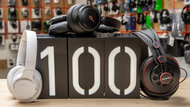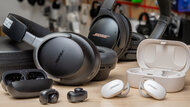- 10.0%Volume
Portability refers to how easy it is to carry a pair of headphones around, whether you're tossing them into a backpack, sliding them into a purse, or just hanging them around your neck. For people who commute, travel, or frequently move between workspaces, how much space your headphones take up when not in use can be a decisive factor when it comes to purchasing time.
In this test, we measure the physical volume a pair of headphones occupies when folded into their most compact form. The higher the score, the smaller the overall volume the headphones take up. We don't take into account the volume of any case the headphones come with (for that, check out our Case test), just the headphones themselves. But we do describe whether the headphones fit into different types of bags, whether they swivel, fold flat, or collapse inward, and how practical they are to carry.
Test results
When It Matters
Portability matters if you need to carry your headphones around with you or frequently move them from place to place. Whether you're packing full-size over-ears into a backpack or slipping earbuds into a pocket, more compact designs are easier to store and transport. Headphones that fold flat or collapse inward take up less space in a bag, and some even come with cases that offer additional protection while you're on the go. Regardless of your use case, a smaller volume can make your cans much easier to transport.
Our Tests
We measure the length, width, and thickness of a pair of headphones when folded into their most compact format. This helps us evaluate how much space they will occupy in a bag, purse, or pocket when being transported. Headphones that take up a smaller volume receive a higher overall score for this test.
Volume
 |  |
Smaller headphones take up less space and usually receive higher scores as a result. However, some larger models use folding or swivelling mechanisms to reduce their footprint, and we account for that in both our measurements and scoring.
What this test doesn't cover
This test doesn't assess any cables the headphone may come with, or things like battery life. If the headphones come with a case, we'll mention it, but it doesn't affect their portability score. For more information on other aspects that affect headphone usability while out and about, check out our test articles on Case, Battery Life, Build Quality, and Controls.
Conclusion
Portability plays a big role in how convenient headphones are for everyday use, especially if you're frequently on the move. A more compact design can make them easier to carry, store, and fit into your daily routine. Our portability test provides an objective way to compare how much space different models take up when stored in their most compact format. The higher the score, the smaller the volume the headphones take up. If you travel often or need to pack your gear regularly, this information can help you choose the right pair of headphones for your needs.
Recent Updates
- 07-07-2025: We updated this article with clarifications to common questions from our readers.














































































